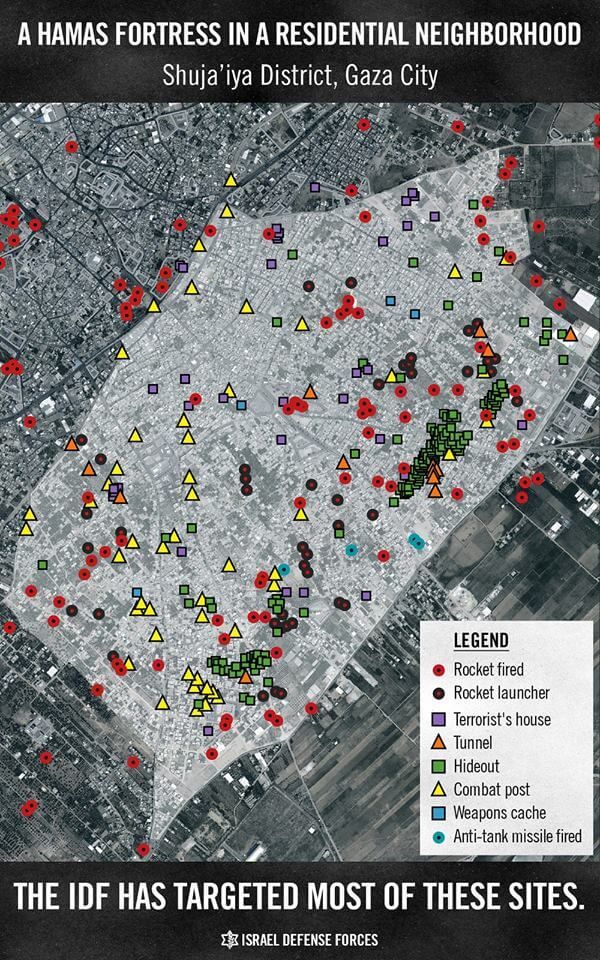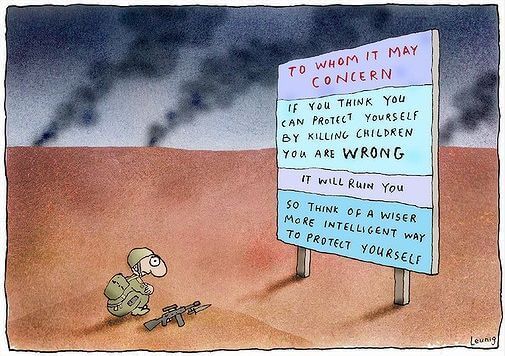Today’s Top Stories
1. India’s NDTV was the first news service to capture Hamas men at work. If you set up rocket launchers in civilian areas — especially next to a hotel where journalists are staying — you’re bound to be filmed surreptitiously. NDTV said that reporter Sreenivasan Jain and his crew left Gaza before filing this video.
France 24‘s Gallagher Fenwick also discovered a Hamas rocket launching site a mere 50 meters from a hotel where journalists are staying (is it the same hotel as NDTV? ) and 100 meters from a UN facility. No word on whether Fenwick left Gaza before filing this report.
2. A captured Hamas combat manual explains benefits of human shields. And the Jerusalem Post points out that this manual could help Israel block war crimes trials.
The IDF said that the manual: 1) reveals that Hamas knows or recognizes the IDF is committed to minimizing harm to civilians 2) explains how the civilian population can be used against IDF forces and 2) Based on these two points, the IDF stated that Hamas’ callous and systematic use of the Gazan population as “human shields” was intentional and preplanned . . .
The manual goes on to explain that the presence of civilians among pockets of resistance causes three major problems for IDF forces: (1) Problems with opening fire (2) Problems in controlling the civilian population during operations and afterward (3) Assurance of supplying medical care to civilians who need it Lastly, the manual discusses the benefits for Hamas when civilian homes are destroyed: The destruction of civilian homes: This increases the hatred of the citizens towards the attackers [the IDF] and increases their gathering [support] around the city defenders (resistance forces[i.e. Hamas]).
See also CNN coverage.
3. Anti-Semitism continued to rear its ugly head around the world: Sydney Jews are on edge after a group of racists boarded a school bus yelling “Kill the Jews”and threatening to cut kids’ throats. Italy expelled a Moroccan imam accused of making violently anti-Semitic comments in a Venice mosque. A British supermarket chain was forced to close some of its stores by pro-Palestinian protesters. Protesters yelled “Heil Hitler” in Calgary. A rabbi attacked in Sweden days after his synagogue was vandalized. Holland‘s chief rabbi was attacked for the fifth time. New York Jewish institutions are stepping up security. The Jewish communities of Latin and South America are shaken that Brazil, El Salvador, Ecuador, Chile, and Peru recalled their ambassadors from Israel.
In recent weeks, he adds, there have been anti-Semitic incidents in Brazil, for the first time.

4. If you’re in New York City on Thursday, be sure to come to the Support Israel Rally Against Biased Media. HonestReporting CEO Joe Hyams will be among the speakers.
Where: 58th St. between 8th and 9th Avenues (Columbus Circle)
When: Thursday, August 7, 6:00-9:00 pm
Spread the word, and share this with friends. And be there to support Israel, learn how you can be better informed, and send a message to the news services that the public is holding them accountable. Details at the rally’s Facebook page.
5. Gaza: What Could the Press Corps Have Done Differently? The biggest lesson of the Gaza war is the media’s need to be transparent with readers.
6. Foul-Mouthed Australian Columnist Quits Over Israel Flap: Pouring fuel on the fire, Mike Carlton’s emails and tweets alarmed readers, editors, even top news executives.
7. Media Uncovers Hamas Launch Sites in Populated Areas: Mainstream media videos finally document Hamas putting Gaza civilians at risk.
Operation Protective Edge
• For details on today’s developments, see live-blogs at the Jerusalem Post, Haaretz, Times of Israel, and i24 News. (See also yesterday’s liveblogs at the Jerusalem Post, Haaretz, Times of Israel, and i24 News.)
• Washington Post correspondent Sudarsan Raghavan raises the specter of staged photos coming out of Gaza:
The scene was too neat.
I had just arrived outside the shattered remains of a large mosque in central Gaza City last week. It had been pulverized by an Israeli airstrike. There was rubble, glass and metal everywhere. But on a patch of ground in front of the structure, visible for everyone to see, was a small, dusty carpet.
On top lay piles of burned, ripped copies of the Koran, Islam’s holy book. The symbolism was obvious, almost too perfect. It was clear that someone had placed them there to attract sympathy for the Palestinian cause. A television crew spotted the pile and filmed it. Mission accomplished.
• The 72-hour ceasefire is holding so far as diplomats in Cairo to hammer out a longer-term truce. Take your pick of AFP or Washington Post coverage.
• Gazans who have lost everything want to continue fighting.
• The Ministry of Foreign Affairs has recommended against cooperating with any commission of inquiry from the UN Human Rights Council, according to YNet.
• New York Times bureau chief Jodi Rudoren analyzed the contentious casualty count:
An analysis of the statistics provided by both sides suggests that a majority were probably noncombatants. Through last Thursday, according to a New York Times analysis of a list provided by the Health Ministry, more than a third were women, children under 15 or men over 60.
But the difference between roughly half the dead being combatants, in the Israeli version, or barely 10 percent, to use the most stark numbers on the other side, is wide enough to change the characterization of the conflict . . .
The Times analysis, looking at 1,431 names, shows that the population most likely to be militants, men ages 20 to 29, is also the most overrepresented in the death toll: They are 9 percent of Gaza’s 1.7 million residents, but 34 percent of those killed whose ages were provided. At the same time, women and children under 15, the least likely to be legitimate targets, were the most underrepresented, making up 71 percent of the population and 33 percent of the known-age casualties.
• As residents returned to Rafah, residents confirmed to Associated Press one example of Hamas operating in civilian areas:
Asmahan Ismail Abu al-Rous started wondering a year ago about the cause of the cracks on the walls of her Gaza home. When she asked some of her more savvy neighbors, they told her: Militants were digging an attack tunnel not far away.
“I did not think much about it then. I thought that was the resistance’s business, not mine,” the widowed mother of four said Tuesday, standing amid the ruins of her two-story home in the Shawkah district, an eastern section of Rafah near Gaza’s border with Egypt.
Barely 50 meters (yards) away, according to villagers, is an entrance of the tunnel where Hamas fighters emerged Friday to attack Israeli soldiers.

• The Jerusalem Post details some of the destruction caused by Hamas: extensive destruction caused by Hamas booby traps, cross-border tunnel shafts next to Gaza kindergartens, launch tripods in playgrounds, heavy arms found in children’s bedrooms, and homes destroyed by secondary explosions.
• The International Criminal Court stated that it can’t play a role in Gaza because it doesn’t currently have jurisdiction over the Palestinian territories. The statement didn’t elaborate further, reports AP/Times of Israel.
• According to David Ignatius, John Kerry’s trying to craft an ambitious long-term ceasefire would re-install the PA in Gaza. But Khaled Abu Toameh reports that Mahmoud Abbas continues strengthening ties with Hamas at the expense of a peaceful solution with Israel.
• Better late than never: Israeli media reports say the government’s probing the possibility of terror tunnels leading in from Lebanon.
• A security guard in Maale Adumim suffered moderate injuries after being stabbed by a Palestinian. Times of Israel coverage.
• Israeli security forces arrested a man believed to be the head of the terror cell that kidnapped and killed Eyal Yifrach, Gil-ad Shaar, and Naftali Frankel. See Eli Lake‘s coverage.
• Collateral damage, Hamas-style? Maan News reports that a Gaza rocket hit a Bethlehem-area home. Nobody was injured, but the house and the electrical network in Beit Sahour were damaged.
• JTA: With army protection, Israel Electric Corp. technicians are repairing electrical lines connecting Israel and Gaza.
• Can’t say this surprises me. I’m sure the UN’s silence will be deafening:
Iran says it gave missile technology to Hamas
• CNN‘s Wolf Blitzer confronted Osama Hamdan over a blood libel the Hamas spokesman raised a few days ago (and caught by MEMRI). Hamdan wouldn’t give a straight answer about Jews using Christian blood in Passover matzos, but to be fair, he insists he has Jewish friends . . .
• Angry Palestinians attack Hamas official over Gaza destruction: Hamas police had to rescue spokesman Sami Abu Zuhri.
Arabic website vetogate.com said that reporters in Gaza are well aware of the incident but are afraid to report it, because Hamas’s security agency could go after them if they do.
• Leave it to Iran to dream up a creative way to legitimize future terror tunnels.
Hamas should let civilians hide in its tunnels
• Spain halted arms sales to Israel. But the Times of Israel says the move is symbolic and will be reviewed in September.
• Globes takes a look at the cost of restoring Gaza’s devastated infrastructure. The full scope of damage still isn’t known, but $5 billion appears to be a conservative estimate.
• Baroness Sayeeda Warsi, Britain’s first Muslim cabinet member, resigned her post in protest of her government’s response to the Gaza crisis. Reuters explains the significance:
Warsi’s resignation is embarrassing for Cameron, who has been accused of filling his government with too many middle-class white males. Warsi was not a full cabinet member but had the right to attend and played an important role in mediating between the government and Britain’s Muslim community.
• Worth reading: No easy answers to charges of war crimes in Gaza
• I’m rubbing my eyes at this headline too:
Media Angles
• It sucks to be be a Syrian. I blame the media. Haaretz has me wondering if the press corps’ infographics and casualty count breakdowns are only when Palestinians are the victims.
If June was Iraq’s month, July belongs to the Palestinians, even though that month saw hundreds die in Iraq and over 1,500 Syrians killed in a single week in July — slightly higher than the Palestinian death toll. Syria, though, has been pushed to the bottom of the world’s list of priorities. No new diplomatic endeavors were launched to solve the crisis there this month. The international commissions discussing the Syrian civil war have gone on summer recess.
I’m not the only one blaming the media. Bret Stephens (Wall St. Journal via Google News) slams the saturation coverage Gaza, using an Associated Press report of a Pakistani offensive against terror groups as starting point.
• Is Yvonne Ridley ethnically cleansing Scotland?
• Philippe Assouline nails the photos coming out of Gaza:
When one is relentlessly subjected to heartbreaking scenes of the same suffering, the crucial moral context of that suffering – the relative responsibility of the parties, their motivations, the potential solutions – recedes into irrelevance. Endlessly shocked with grisly footage of Gaza’s dead and dying, beset with eulogizing anecdotes and rubble-strewn interviews of the bereaved, we become powerless to do anything more than to grieve and demand an end to the fighting. Not a solution and not an end to the problem; and end to the pain. Exceedingly rare is the report that offers an alternative means of dealing with the immediate threat of militarized, urban-based terrorism.
• Here’s a new low: The Lancet’s refusing to publish letters by Israeli academics.
• The Times of London rejected an advertisement featuring Elie Wiesel against Hamas and its “child sacrifice.”
The London Times refused the ad because “the opinion being expressed is too strong and too forcefully made and will cause concern amongst a significant number of Times readers,” according to a statement from a representative of the newspaper, the Observer reported.
• Michael Calderone discussed Israeli military censorship with New York Times bureau chief Jodi Rudoren and one of her editors.
• Israeli officials continued their media offensive. Ofir Gendelman, serves as Bibi’s Arabic-speaking spokesman, and I wonder if this Al Jazeera interview (video/transcript via MEMRI) is typical of what he puts up with from the Arab journalists. CNN talked to Ambassador Ron Dermer and Yuval Steinitz, Naftali Bennett appeared on Sky News, and Yair Lapid weighed in at the Huffington Post. And finally, although he’s a private citizen, ex-ambassador Michael Oren discussed cease fire possibilities and what Israel would consider a victory with MSNBC.
• See also Clifford May (Hamas rules), Richard Landes (The media’s role in Hamas’ war strategy), Douglas Murray (Does anyone care that Hamas censors the media?), Paul Alster (Israel wins war, but is badly wounded by media coverage),
Commentary/Analysis
• What Would Hamas Do If It Could Do Whatever It Wanted?
• Jimmy Carter and Mary Robinson co-wrote a Foreign Policy commentary calling on Israel and the US to bring Hamas in from the cold:
Only by recognizing its legitimacy as a political actor — one that represents a substantial portion of the Palestinian people — can the West begin to provide the right incentives for Hamas to lay down its weapons.
In The Independent, David Steel makes a similar argument.
• Michael Leunig of The Age turns his poison pen to Israel:

• In today’s New York Times‘ Room for Debate, Daniel Gordis, Jonathan Schanzer, Jessica Montell, Rashid Khalidi, Mona Charen, and others weigh in on whether the US can still help achieve a sustainable Israeli-Palestinian peace.
• For more commentary, see David Horovitz (Israel may have won, Hamas certainly lost), Elliott Abrams (Hamas’s War for Cash), Ben-Dror Yemini (West encourages terror with “massacre” claims), Eugene Kontorovich (Palestine’s Egypt problem at the ICC), Danny Rubinstein (Count on Egypt to finish Hamas off), Rick Francona (Hamas on the ropes), Tom Friedman (Revelations in the Gaza war), Emmanuel Navon (Losing the battle, winning the war), Roger Cohen (Start with Gaza), Andrew Nagorski (Camouflaged as humane concern, anti-Semitism flourishes — Wall St. Journal via Google News), and a Christian Science Monitor staff-ed.
For a sense of what the other side’s saying, see the Sydney Morning Herald.
Rest O’ the Roundup
• Egypt announced plans to build a second Suez canal running parallel to the existing channel. The $8.4 billion project is expected to take three years to build. What does this mean for Israel’s planned $2 billion Red-Med rail link?
Image: CC BY-SA flickr/Karsten Seiferlin
For more, see yesterday’s Israel Daily News Stream and join the Israel Daily News Stream on Facebook.




